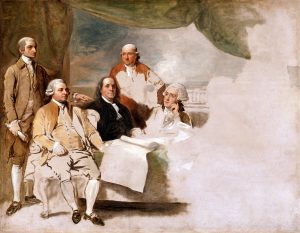France has an extraordinary way of commemorating the glorious past through landmarks and monuments. Benjamin Franklin had been an off and on resident of Paris living at 66 rue Raynouard, the former Hotel de Valentinoise, in Passy. He was recognized as the first official diplomat and Ambassador of the thirteen American colonies. There is a magnificent statue of the man located on the southwest corner of the Place du Trocadero, where one has an excellent view of the Eiffel Tower. The exact street where the monument is found has been, since 1791, called Rue Benjamin Franklin. When the statue was dedicated in 1906, a New York Times article declared that it represented “France’s unwavering friendship to the United States.”
Incredibly, the location of Franklin’s statue is called Le Square de Yorktown, commemorating the 1781 battle between the combined forces of George Washington, the Marquis de Lafayette and the French General Rochambeau. The decisive defeat of the British and the capture of British General Cornwallis and his army forced the British to negotiate for peace, thus ending the American Revolutionary War.

Naturally, at the end of hostilities in 1781, Franklin was called upon, with John Jay and John Adams, to negotiate peace with Great Britain and settle outstanding differences among other world powers such as Spain, the Netherlands, and France itself. The peace conference began in Paris on June 25, 1783. The eventual agreement was finalized and signed on September 3, 1783 at the Hotel York, located at56 rue Jacob. With amazing foresight, one of the more noteworthy provisions secured by this treaty was the establishment of boundaries which allowed for America’s westward expansion.
A plaque recognizing the agreement’s signing is still found today at 56 rue Jacob, which is a lovely street near the Seine River, running between the National Academy of Medicine and the Universite’ Paris Cite’.

To commemorate the event, artist Benjamin West was commissioned to paint the men’s portrait. John Jay, John Adams, Benjamin Franklin, Henry Laurens, and William Temple Franklin were all duly rendered by the artist. British delegates Richard Oswald and Caleb Whitefoord were meant to be in the painting but, still smarting from the humiliating loss of their American colonies, they refused to pose for the artist and the painting was left unfinished.








Recent Articles
Teaching About the Black Experience through Chains and The Astonishing Life of Octavian Nothing
Review: Philadelphia, The Revolutionary City at the American Philosophical Society
Joseph Warren, Sally Edwards, and Mercy Scollay: What is the True Story?
Recent Comments
"The 1779 Invasion of..."
Sorry I am not familiar with it 2 things I neglected to...
"“Good and Sufficient Testimony:”..."
I was wondering, was an analyzable database ever created? I have been...
"Joseph Warren, Sally Edwards,..."
Thank you for bringing real people, places and event to life through...